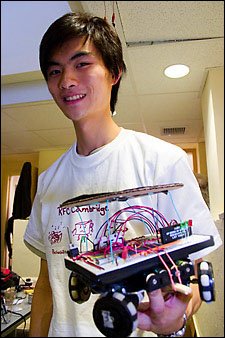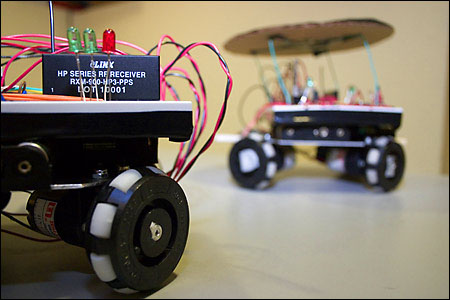Kicking and scheming – robot soccer
Harvard, MIT team up to play ‘robotball’

In a suite of newly remodeled offices in the basement of Pierce Hall, a group of undergraduates huddles near a whiteboard besmirched with diagrams. Laptops glow. Uncompleted circuit boards lay scattered across tables like abandoned blue books. A blur of voices doesn’t make the scene any less puzzling: “We have something here, and we have something there, and they might be the same color … they’re of the same bot. … What he’s saying is that so instead of going ‘0,0,0,0,’ you just keep a list of all the same blobs.”
Physics concentrator Jeff Ma ’07 and Kristina Haller, a mechanical engineering major from the Massachusetts Institute of Technology (MIT), monitor the situation with perfect ease and understanding. The co-founders of the Robotic Futbol Club of Cambridge (RFC), while still scrambling for every free second before, between, and after classes, remain nearly on schedule. The $30,000 grant the RFC won from the MIT-sponsored and Microsoft-funded iCampus initiative in January may also explain their cool composure. As important, the students have opted for intellectual collaboration rather than competition along their shared stretch of the Charles.
“I started the Harvard College Engineering Society last year with the help of Computer Science concentrator Jie Tang [’08]” says Ma. “We were looking for an ambitious engineering competition in which to compete, and after much searching we came across RoboCup.”
Haller, fresh from the frenzy of a Battlebots competition (a mechanized gladiatorial melee) was also looking for a new challenge. She says, “I found out that Harvard was starting a team through Jie, my boyfriend. Because RoboCup is a more comprehensive project involving more disciplines and resources, I suggested to the MIT Battlebots team that we should work with Harvard.”
RoboCup, an international robotic football (American soccer) competition created to “foster AI and intelligent robotics research,” offers university-based teams the chance to build a team of autonomous robots (some near human scale) and compete in head-to-head matches. The Harvard-MIT team aims to enter the F-180, or small-sized league competition. Imagine two teams of five mini-sized Roombas, those little automatic vacuums, sweeping across an Astroturf field the size of an area rug, trying to grab and roll or kick an orange golf ball into a net guarded by a goalie.

As in real football, the ersatz athletes must follow the traditional rules of hands-free play, but with a slight twist. Once the mechanical athletes roll onto the field only smart design and smart programming may guide them to victory. Unlike the popularized televised robotic warfare Haller participated in, RoboCup is more like acrobatic chess, where tactics count more than brute force. In fact, the competition prohibits any harassment, such as trapping opponents in the corner or, needless to say, cleaving an adversary in two with a buzz saw attachment. The football-playing bots may be far less fierce, but they are no less difficult to design.
“Our robots are not being built from a kit. There are no pre-selected parts and no TA’s to ‘check us off’ and to make sure we did our work,” says Haller.
So the bots can “see” one another, who they’re up against, and where to go, the RFC will rely on global vision. The system uses an overhead camera and off-field PC to identify and track the players; a computer program identifies positions by homing in on colored ovals atop each player, and, thereby, acting as a silent coach. Getting a single bot to behave, let alone five to pass, kick, and defend in coordination, takes a great deal of technical skill. RFC’s success will ultimately depend on implementing the right blend of computer design, circuit building, mechanical engineering, and robust artificial (and some professorial) intelligence.
“We have access to some of the top professors in the world,” Haller says. “The Edgerton Center [at MIT] and [Harvard’s] Division of Engineering and Applied Sciences [DEAS] have gone above and beyond to make sure that we have everything that we need.” For advice and inspiration, students have relied on MIT’s David Trumper, a renowned expert in mechatronics, and Daniela Rus, a MacArthur Genius winner and a leader in distributed robotics. At Harvard, Assistant Professor of Computer Science Radhika Nagpal, a rising star in biomemetic computing, and Howard Stone, associate dean for academic programs at DEAS, have been active mentors to the club.
Ma also expects to seek some athletic advice in the near future. “While we’re now concerned with getting the hardware to work with the software, eventually we will need to talk to a lot of soccer players to see what strategy works best for stealing or getting the ball,” he says. Luckily, the RFC team can test and evaluate designs and strategy on the screen before any shins or circuits get bruised.
Ironically, one of the RFC team’s greatest challenges has been all-too-human, navigating the traffic jams clogging Mass Avenue. “The biggest difficulty in getting the project to work was the transportation logistics,” says Ma. Simply getting to and from the campuses eats away precious time better spent on soldering or coding. Haller agrees but has stayed focused on the journey ahead: making sure the team is ready to compete in the RoboCup US Open (April 22 – 24 at Georgia Institute of Technology) and the international competition (June 14-20 in Bremen, Germany).
“I am really excited!” says Haller. “As the robots begin to take on their definite designs and we start building, I think lots of people are getting really pumped.”
While former Harvard President Charles William Eliot’s dreams of merging with MIT in 1905 were dashed by the courts (and the ire of alumni), more than a century and a half later a synthetic sporting event has brought the two institutions together. “The competition this year does not mark the end of RFC Cambridge,” says Ma. “One of our main goals is to build an organization that will outlast the current board and, one day, be able to dominate the RoboCup league.” One suspects that Eliot would applaud such a goal, even if he may have never imagined a robot being able to score one.




